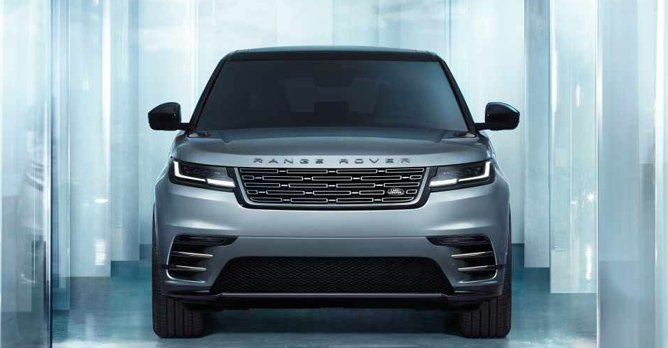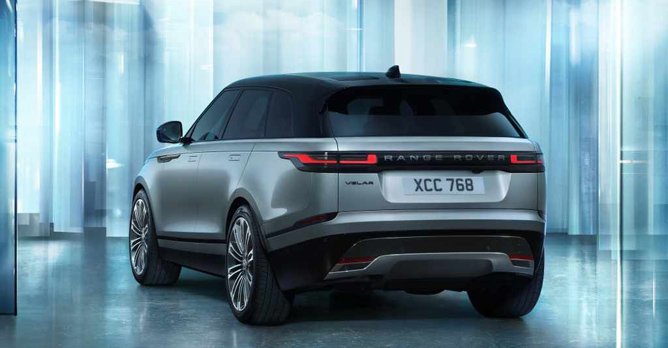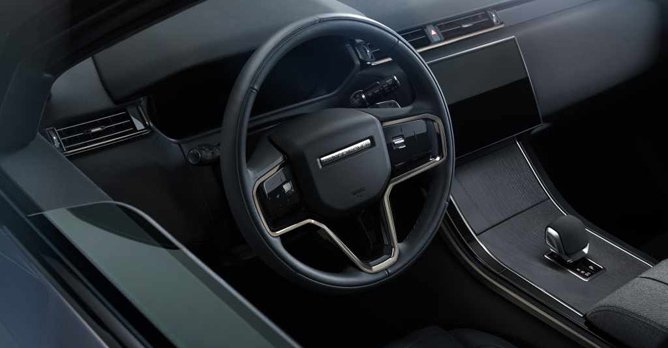Land Rover unveils new Range Rover Velar
06 Feb 2023|1,841 views
Land Rover has revealed the updated Range Rover Velar.
The Porsche Macan, BMW X3 and Mercedes-Benz GLC rival now gets a redesigned grille as well as new Pixel LED head lights. Equipped with Dynamic Bend Lighting technology, the head lights make use of vehicle speed and steering data to respond to curves on the road and illuminate dark corners and verges.
A new lower rear bumper complete with new dark accents, is also said to grace this updated model.
At the rear, the tailpipes of the Velar are now hidden, while the taillights have also been updated. A full-length high-level stop-lamp also now joins the new rear lights.
In the cabin, the changes to the new Range Rover Velar are more apparent.
A single floating 11.4-inch curved glass touchscreen now offers access to the firm's Pivi Pro infotainment system, which now gets permanently visible bars at the sides, for easy access to the media and navigation menus, as well as for quick access to the various car cameras.
Gone is the separate 10.0-inch screen that offers access to the air-conditioning controls present in the previous car. Instead, the centre console of this new Range Rover Velar gets a simplified centre console, with a new stowage area below the touchscreen.
Land Rover states that the new Velar is now the quietest vehicle in its class for road noise, thanks to the addition of Active Road Noise Cancellation technology.
The petrol-only range of the Range Rover Velar now starts with a 2.0-litre four cylinder drivetrain, which is paired to an eight-speed transmission, which Land Rover states is now smoother when executing shifts. With an output of 247bhp and peak torque of 365Nm, this P250 Velar will take 7.5 seconds to hit 100km/h from a standstill.
The top P400 petrol variant, meanwhile, will offer a total of 395bhp and 550Nm of peak torque from a 3.0-litre six-cylinder engine, which will allow the car to hit 100km/h in 5.5 seconds.
Just as interesting, perhaps, is a new P400e plug-in hybrid variant, which combines a 2.0-litre four-cylinder engine with 141bhp electric motor fed via a 19.2kW battery. This battery, can also be charged via a direct current source at a maximum speed of 50kW.
The Porsche Macan, BMW X3 and Mercedes-Benz GLC rival now gets a redesigned grille as well as new Pixel LED head lights. Equipped with Dynamic Bend Lighting technology, the head lights make use of vehicle speed and steering data to respond to curves on the road and illuminate dark corners and verges.
A new lower rear bumper complete with new dark accents, is also said to grace this updated model.
At the rear, the tailpipes of the Velar are now hidden, while the taillights have also been updated. A full-length high-level stop-lamp also now joins the new rear lights.
In the cabin, the changes to the new Range Rover Velar are more apparent.
A single floating 11.4-inch curved glass touchscreen now offers access to the firm's Pivi Pro infotainment system, which now gets permanently visible bars at the sides, for easy access to the media and navigation menus, as well as for quick access to the various car cameras.
Gone is the separate 10.0-inch screen that offers access to the air-conditioning controls present in the previous car. Instead, the centre console of this new Range Rover Velar gets a simplified centre console, with a new stowage area below the touchscreen.
Land Rover states that the new Velar is now the quietest vehicle in its class for road noise, thanks to the addition of Active Road Noise Cancellation technology.
The petrol-only range of the Range Rover Velar now starts with a 2.0-litre four cylinder drivetrain, which is paired to an eight-speed transmission, which Land Rover states is now smoother when executing shifts. With an output of 247bhp and peak torque of 365Nm, this P250 Velar will take 7.5 seconds to hit 100km/h from a standstill.
The top P400 petrol variant, meanwhile, will offer a total of 395bhp and 550Nm of peak torque from a 3.0-litre six-cylinder engine, which will allow the car to hit 100km/h in 5.5 seconds.
Just as interesting, perhaps, is a new P400e plug-in hybrid variant, which combines a 2.0-litre four-cylinder engine with 141bhp electric motor fed via a 19.2kW battery. This battery, can also be charged via a direct current source at a maximum speed of 50kW.
Land Rover has revealed the updated Range Rover Velar.
The Porsche Macan, BMW X3 and Mercedes-Benz GLC rival now gets a redesigned grille as well as new Pixel LED head lights. Equipped with Dynamic Bend Lighting technology, the head lights make use of vehicle speed and steering data to respond to curves on the road and illuminate dark corners and verges.
A new lower rear bumper complete with new dark accents, is also said to grace this updated model.
At the rear, the tailpipes of the Velar are now hidden, while the taillights have also been updated. A full-length high-level stop-lamp also now joins the new rear lights.
In the cabin, the changes to the new Range Rover Velar are more apparent.
A single floating 11.4-inch curved glass touchscreen now offers access to the firm's Pivi Pro infotainment system, which now gets permanently visible bars at the sides, for easy access to the media and navigation menus, as well as for quick access to the various car cameras.
Gone is the separate 10.0-inch screen that offers access to the air-conditioning controls present in the previous car. Instead, the centre console of this new Range Rover Velar gets a simplified centre console, with a new stowage area below the touchscreen.
Land Rover states that the new Velar is now the quietest vehicle in its class for road noise, thanks to the addition of Active Road Noise Cancellation technology.
The petrol-only range of the Range Rover Velar now starts with a 2.0-litre four cylinder drivetrain, which is paired to an eight-speed transmission, which Land Rover states is now smoother when executing shifts. With an output of 247bhp and peak torque of 365Nm, this P250 Velar will take 7.5 seconds to hit 100km/h from a standstill.
The top P400 petrol variant, meanwhile, will offer a total of 395bhp and 550Nm of peak torque from a 3.0-litre six-cylinder engine, which will allow the car to hit 100km/h in 5.5 seconds.
Just as interesting, perhaps, is a new P400e plug-in hybrid variant, which combines a 2.0-litre four-cylinder engine with 141bhp electric motor fed via a 19.2kW battery. This battery, can also be charged via a direct current source at a maximum speed of 50kW.
The Porsche Macan, BMW X3 and Mercedes-Benz GLC rival now gets a redesigned grille as well as new Pixel LED head lights. Equipped with Dynamic Bend Lighting technology, the head lights make use of vehicle speed and steering data to respond to curves on the road and illuminate dark corners and verges.
A new lower rear bumper complete with new dark accents, is also said to grace this updated model.
At the rear, the tailpipes of the Velar are now hidden, while the taillights have also been updated. A full-length high-level stop-lamp also now joins the new rear lights.
In the cabin, the changes to the new Range Rover Velar are more apparent.
A single floating 11.4-inch curved glass touchscreen now offers access to the firm's Pivi Pro infotainment system, which now gets permanently visible bars at the sides, for easy access to the media and navigation menus, as well as for quick access to the various car cameras.
Gone is the separate 10.0-inch screen that offers access to the air-conditioning controls present in the previous car. Instead, the centre console of this new Range Rover Velar gets a simplified centre console, with a new stowage area below the touchscreen.
Land Rover states that the new Velar is now the quietest vehicle in its class for road noise, thanks to the addition of Active Road Noise Cancellation technology.
The petrol-only range of the Range Rover Velar now starts with a 2.0-litre four cylinder drivetrain, which is paired to an eight-speed transmission, which Land Rover states is now smoother when executing shifts. With an output of 247bhp and peak torque of 365Nm, this P250 Velar will take 7.5 seconds to hit 100km/h from a standstill.
The top P400 petrol variant, meanwhile, will offer a total of 395bhp and 550Nm of peak torque from a 3.0-litre six-cylinder engine, which will allow the car to hit 100km/h in 5.5 seconds.
Just as interesting, perhaps, is a new P400e plug-in hybrid variant, which combines a 2.0-litre four-cylinder engine with 141bhp electric motor fed via a 19.2kW battery. This battery, can also be charged via a direct current source at a maximum speed of 50kW.
Latest COE Prices
November 2025 | 2nd BIDDING
NEXT TENDER: 03 Dec 2025
CAT A$109,000
CAT B$129,890
CAT C$76,389
CAT E$125,001
View Full Results Thank You For Your Subscription.





























